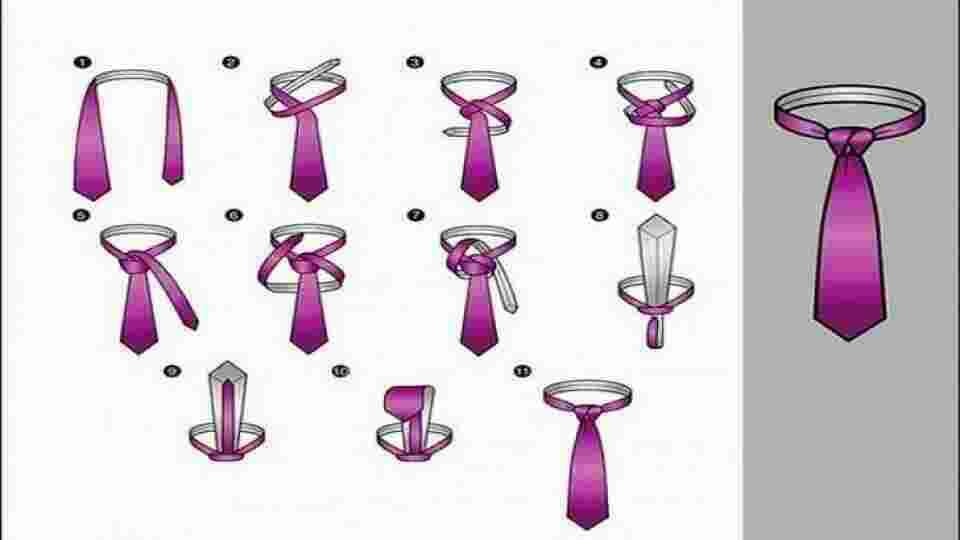How to tie a tie?
From education to business, men have an endless problem: tie-tie.
So, isn't there really an easy way around this tie tying thing?
Of course there are!
here are the most practical tie tying techniques.
The simple knot technique, which is the most classic and preferred type among tie knots, is also known as Four in hand.
Since it is one of the most classic methods, a tie made with a simple knot system can be applied to all shirt collars.
Ties made with the simple knot technique, which has a long and conical structure, are used narrowly in thin fabric products and widely in thick fabric products.
How to tie the tie with the double knot technique?
You can easily find the answer with the illustrated narration.
The double knot method, also known as Victoria, is a tie tying method that is very similar to the simple knot technique but requires a second turn.
To tie a tie with a double knot, first of all, the wide end of the tie should go around the narrow end twice.
Ties made with the double knot technique have a thicker appearance than the ties made with simple knots.
If the fabric of the tie is not excessively thick, the ties made with the double knot technique can also adapt to many shirt collars.
Windsor nodes are divided into half windsor and full windsor.
The half windsor knot, which is similar to the full windsor knot you will have the chance to examine at the bottom, but is easier to make and thicker in structure, is more suitable for thin or light fabric ties.
The triangle-shaped half windsor knot, which has a stylish appearance, is generally preferred in shirts with open collars or classic collars.
As the name suggests, the knot of the ties tied with the small knot technique is tiny.
The small knot technique, which is preferred in tight-collared shirts or ties with very thick fabric, should not be used in long-collared or split-collar shirts.
In this type of collar, small knotted ties may not give a pleasant look.
The small knot technique is also one of the easy ways to tie a tie.
The full windsor knot is a type of tie tying known as the knot of special occasions.
The full windsor knot, which appears as a UK-style knot, takes its name from the Duke of Windsor.
Since the ties made with the full windsor technique have a voluminous structure, they are generally preferred in split collar products such as Italian collars and Windsor necklines.
Tying a tie with a full windsor knot may seem a bit tricky, but for a successful tying, the tie needs to hide the shirt's last button.
Ties made with the Christensen technique usually have a thick knot structure.
Therefore, it will be more logical to choose the ties you create with the Christensen knot in shirts with a longer collar with a more split collar.
Shirts with small collars will not be able to carry ties created with the Christensen knot technique.
The Grantchester technique is a tie tying method that attracts attention with its stylish and elegant appearance.
In particular, the fact that the tie knot gives a flat appearance in contrast to the simple knot and double knot methods is one of the factors that make the Grantchester tie tying technique one step ahead.
When you successfully apply the steps in the illustrated narrative, it will be possible to apply the ties you will make with this technique to each shirt collar.
Of course, if your tie fabric is too thin or too thick, you may need to choose shirts with wide collars or small collars.
Cafe knot, which is a tie tying technique that we do not encounter much in Turkey, is a complex method consisting of 11 steps.
As can be understood from the illustrated narration, you can draw attention to the invitations with the café knot, which aims to perform multiple agile movements with the tie tip and give a different image to the tie knot.
How to tie a tie? Fast and easy method?
There are several different ways to tie a tie, but some methods are considered to be easier or more beginner-friendly than others. Here are a few common tie-tying techniques:
The Four-in-Hand Knot: This is one of the simplest and most popular tie-tying methods. To tie a Four-in-Hand Knot:
Start with the wide end of the tie on your right side and the narrow end on your left.
Cross the wide end over the narrow end.
Bring the wide end up and over the knot, then down through the loop.
Tighten the knot by pulling down on the narrow end.
The Half Windsor Knot: This knot is slightly more formal than the Four-in-Hand Knot and it creates a symmetrical triangle shape. To tie a Half Windsor Knot:
Start with the wide end of the tie on your right side and the narrow end on your left.
Cross the wide end over the narrow end.
Bring the wide end up and over the knot, then down through the loop.
Bring the wide end over the narrow end and up into the knot.
Bring the wide end down through the loop.
Tighten the knot by pulling down on the narrow end.
The Simple Knot: This knot is similar to the Four-in-Hand, but it is made without the loops. This knot is great for skinny ties and it is simple to tie and perfect for everyday wear.
Start with the wide end of the tie on your right side and the narrow end on your left.
Cross the wide end over the narrow end.
Bring the wide end up and over the knot.
Tighten the knot by pulling down on the narrow end.
The Pratt Knot: The Pratt knot is considered an easy-to-tie and versatile knot. It is a similar to the Half Windsor knot in terms of size and shape.
Start with the wide end of the tie on your right side and the narrow end on your left.
Cross the wide end over the narrow end.
Bring the wide end up and over the knot, then down through the loop
Bring the wide end down over the knot and then up through the loop.
Bring the wide end down over the knot again and then tie by sliding the knot up to your collar.
It is important to note that these instructions are a general guide and it's best to practice the technique a few times before you have to wear it in a formal or important event. And also, you can look for videos of tie-tying techniques on the internet to get a better understanding of the process and make it easier to follow along.


